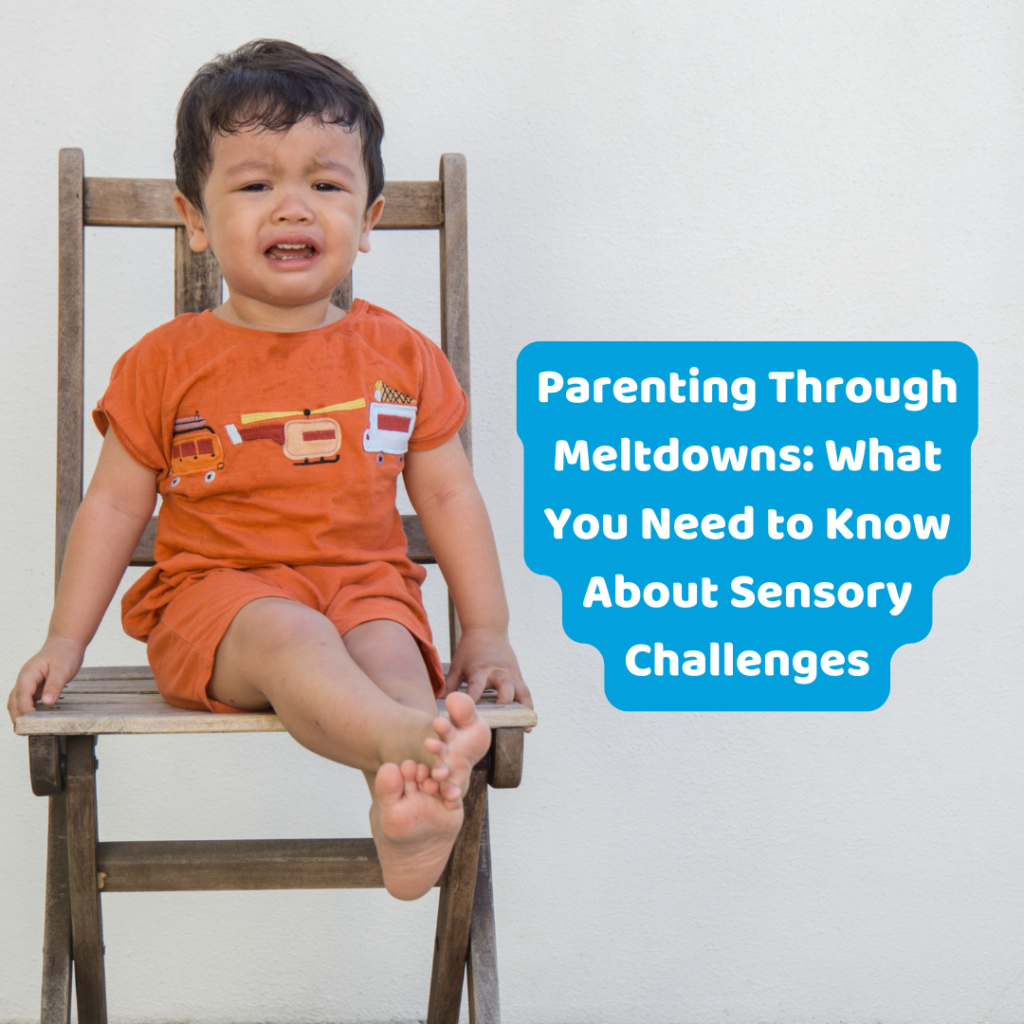As a parent, dealing with your child’s meltdowns can be both emotionally draining and overwhelming. Understanding that these meltdowns might be triggered by sensory challenges can help you respond with patience and clarity.
In this article, we’ll explore what sensory challenges are, why they contribute to meltdowns, and how you can support your child effectively during these episodes.
What Are Sensory Challenges?
Sensory challenges occur when a child’s brain has difficulty processing information from the five senses (sight, sound, touch, taste, and smell) in a way that leads to overstimulation, distress, or discomfort. This can cause a child to become overwhelmed by everyday sensory input such as bright lights, loud noises, or the texture of certain foods and fabrics.
For children with sensory processing issues (which can occur in children with conditions such as autism, ADHD, or sensory processing disorder), their brains are either under-responsive or over-responsive to sensory stimuli, leading to difficulties in handling certain experiences. For example, a child might feel intense discomfort from the feel of a sweater’s fabric, or become overstimulated by the noise in a busy room, which can lead to a meltdown.
How Do Sensory Challenges Lead to Meltdowns?
Meltdowns occur when a child’s sensory overload reaches a point where they can no longer process the information around them. Unlike temper tantrums, which are often driven by a desire for attention or a specific goal, sensory meltdowns are often involuntary reactions to overwhelming stimuli.
Certain sensory triggers that may lead to meltdowns include:
- Loud sounds (e.g., a vacuum cleaner, sirens, or crowded places)
- Bright lights or fluorescent lighting
- Touch (e.g., uncomfortable clothing, messy hands)
- Food textures (e.g., refusal to eat certain foods due to sensory sensitivity)
- Strong smells (e.g., perfumes, cleaning products)
- Changes in routine or environment (e.g., moving to a new room or trying something new)
When a child is unable to process these sensory inputs properly, it may feel like they have no way to escape the discomfort, leading to an overwhelming emotional response, or meltdown.
Signs Your Child Might Be Experiencing Sensory Overload
As a parent, being able to identify the signs of sensory overload early can help you intervene before a meltdown escalates. Some signs that your child might be struggling with sensory challenges include:
- Covering ears or eyes to block out sensory stimuli
- Becoming irritable or upset without an apparent cause
- Avoiding certain textures, foods, or places
- Seeking excessive movement, like spinning or jumping
- Clinginess or difficulty separating from you in new or overstimulating environments
- Sudden outbursts of frustration, crying, or anger
- Unusual physical behaviors, such as rocking, hand-flapping, or avoiding eye contact.
If your child exhibits any of these behaviors, it might be helpful to track them and discuss them with a pediatrician, therapist, or specialist who can provide guidance on sensory processing issues.
How to Support Your Child Through Sensory Challenges
While it can be difficult, there are several ways you can support your child when dealing with sensory meltdowns:
1. Create a Calming Environment
When you notice your child becoming overwhelmed, try to move them to a quieter, calm space. Reducing the level of sensory input (e.g., dimming the lights, turning off loud noises, or moving to a less crowded area) can help your child regain control.
2. Use Sensory Tools and Strategies
For many children, specific tools or strategies can help them self-regulate during sensory overload. These may include:
- Noise-canceling headphones for children sensitive to sound
- Weighted blankets for calming pressure
- Fidget toys or stress balls to provide a soothing tactile experience
- Chewable necklaces or other items that allow for oral sensory stimulation
Offering these tools proactively, or keeping them on hand, can help your child self-soothe during overwhelming moments.
3. Establish Predictable Routines
For children with sensory challenges, unexpected changes in their environment or routine can cause stress. Creating a consistent daily routine can provide a sense of security and predictability for your child. You can use visual schedules or social stories to help them understand what to expect throughout the day.
4. Teach Self-Regulation Skills
Help your child learn ways to manage sensory overload in calm and positive ways. Through therapy or structured activities, children can learn how to use deep breathing techniques, positive self-talk, or simple relaxation exercises to regain control before a meltdown becomes overwhelming.
5. Stay Calm and Supportive
During a sensory meltdown, it’s important for parents to stay calm and patient. Reassure your child with a gentle voice and physical touch (if they are comfortable with it). Avoid using punishment or negative language during this time, as your child is not in control of their emotions and behaviors.
How KidsFirst Can Help
At KidsFirst, we offer specialized programs to help children with sensory processing issues and other developmental challenges. Our Occupational Therapy programs are designed to teach children how to better manage sensory input and develop coping strategies to handle meltdowns and other sensory difficulties.
If you’re concerned about your child’s sensory sensitivities or emotional reactions, contact us today. Our experienced therapists can provide a personalized plan to help your child develop resilience and self-regulation skills.
Contact KidsFirst today to schedule a consultation and learn how our programs can support your child in managing sensory challenges and thriving in daily life!





































